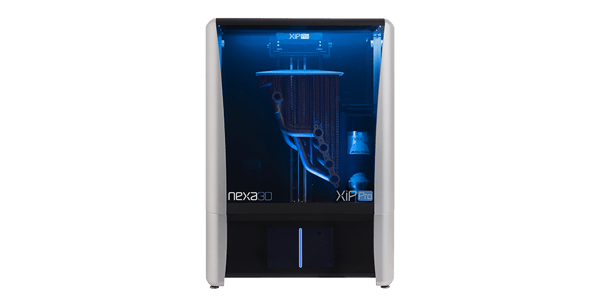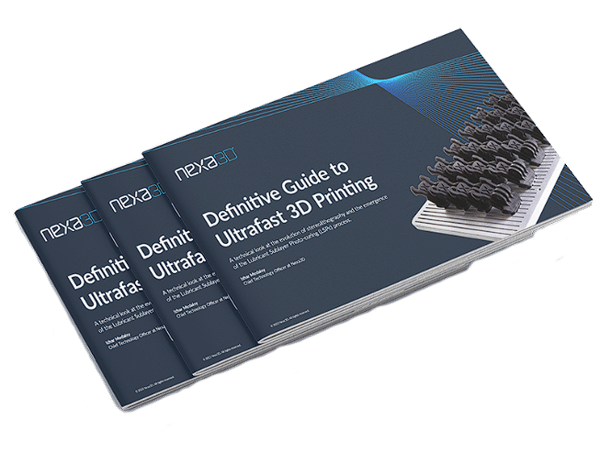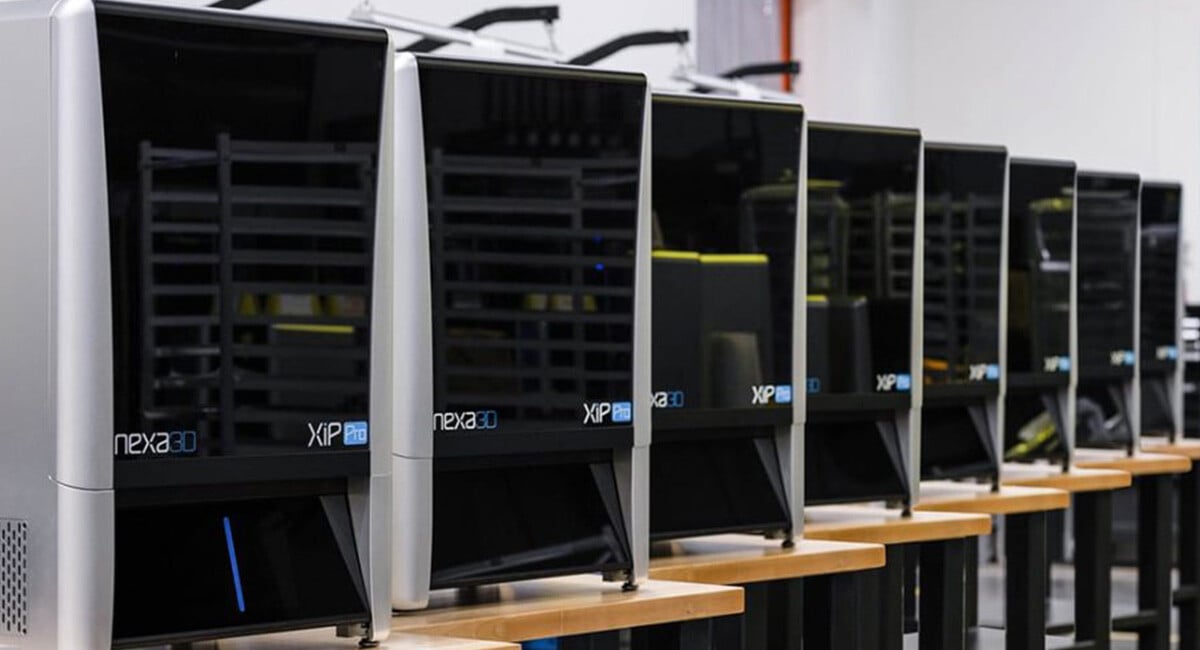In this guide, we’ll explore a wide range of options of 3D printers ranging from budget-friendly desktop printers to the more sophisticated industrial options, all across different printing technologies. So, if you’re interested in staying up-to-date with the latest developments in 3D printing technology–and the best 3D printer options for this year–keep reading.
Original Source - Nexa3D
Finding the right 3D printer for your business can significantly enhance your productivity and profitability. With the market brimming with various 3D printers offering unique features and capabilities, choosing the right one can be difficult.
Best 3D Printers: desktop, industrial, and more
There are a variety of desktop and industrial printers in the market today, each with its unique specifications and capabilities. Some of the best 3D printers include:
1. XiP Pro: Best and Fastest Industrial Resin 3D Printer
Nexa3D XiP Pro is an industrial resin 3D printer that delivers the highest production throughput at the lowest cost of operation. XiP Pro offers the largest 19.5L build volume and fastest print speed in its class–and its unrivaled productivity allows you to produce functional prototypes and final-use parts at previously unattainable production economics.
Various industries use XiP Pro printers for their manufacturing needs. According to Glen Mason, Manager of Advanced Innovation/Industrialisation at DeMarini (a division of Wilson Sporting Goods), “XiP Pro gives us about 10x the throughput of what we had before. Nexa3D has done a really great job taking the costs out of 3D printing while increasing the capacity. Their printers are getting bigger, faster, and more affordable at the same time. It’s a total win for the users.”

3D Printer Specifications:
- 19.5L build volume & 10″ High-Resolution LCD Touchscreen
- Industry-leading print of up to 24 vertical cm per hour
- 7K resolution LCD screen with 46 µm pixel size and 23 µm sub-pixel resolution
- 10″ High-Resolution LCD Touchscreen
- Lubricant Sublayer Photocuring (LSPc) technology
- Advanced sensor package and adaptive layer-by-layer printing technology
- Open material platform with print resolution of 25 µm – 200 µm
Pros:
- Large industrial capacity and compact footprint
- Intuitive NexaX 3D printer software & Smart Resin Delivery System
- Environmental Monitoring System
- LCD-based VAT photopolymerization process uses patented Lubricant Sublayer Photocuring (LSPc) technology
- Self-lubricating membrane enables lighting-fast print speed and unprecedented production value without sacrificing
- print quality or surface finish
- Open material platform (ability to use with third-party resins)
Cons:
- Not for hobbyist 3D printing
- Onlyvused for resin 3D printing processes
- Best For: Prototypes and production applications for engineering, dental, and other industries.
2. Nexa3D XiP: Best 3D Printer for Desktop Resin 3D Printing
Nexa3D makes ultrafast resin 3D printers for designers, engineers, and manufacturers who need to develop and create the products of tomorrow. One of Nexa3D’s fastest printers is the Nexa3D XiP high-performance printer.
The XiP combines a compact footprint with a large build volume and fast print speed to deliver high-quality prototypes for any desktop. It’s patented under Nexa3D’s Lubricant Sublayer Photo-curing (LSPc) technology, which has successfully solved the historical speed vs. quality problem. This technology addresses common concerns over usable power, image homogeneity, heat buildup, layer separation, and resin replenishment cycles during the build process.
The Nexa3D XiP printer also has a build time of about 87 minutes, which allows parts to print up to 10 times faster than other leading 3D printers on the market. XiP is also affordable.

If you want speed, precision, and reliability, the XiP printer is the right choice for you!
Pros:
- Allows users to print at speeds of up to 180 mm per hour.
- Large build volume of 4.8L.
- Provides ultimate flexibility to materials needed.
- Easily upgradeable.
- Easy to operate.
- Open material platform (ability to use with third-party resins).
- Comes with in-built wash packages for post-process.
- Produced from aluminum materials, making it recyclable.
- Modular design.
Cons:
- It’s best for professional printing, not hobbyist printers.
Best for: Prototypes and production-grade applications for engineering, dental, and other industries.
5. Nexa3D QLS230: Best SLS 3D Printer for Economical SLS Printing
The QLS 230 is the most affordable open-platform SLS printer suitable for industrial use. It offers a swift 24-hour cycle speed to increase production while creating high-quality prints out of a wide range of quality materials.
Featuring a generous build volume of 230 x 230 x 230 mm (9.1 x 9.1 x 9.1 inches), the QLS 230 offers ample space for producing large parts or multiple smaller parts simultaneously. Its impressive build speed of up to 20 mm/hour ensures rapid production, allowing users to create high-quality parts efficiently.
The QLS 230 has an open material platform and a single 30W laser for processing 10+ qualified nylon and fusion materials into prototypes or final-use products with robust mechanical properties. In addition, the QLS 230 supports recycled powders from HP® and EOS for ultimate operational and manufacturing sustainability in both polymer and metal part production.
The Nexa3D QLS is another advanced printer in the Nexa3D series that boasts the lowest entry point within its class due to its 20% powder refresh rate and use of third-party materials.

3D Printer Specifications:
- 230 x 230 x 230 mm (9.1 x 9.1 x 9.1 inches) build volume
- 1,480 x 850 x 2,040mm (58.3 x 33.5 x 80.3in) printer dimension
- Build speed of up to 20 mm/hour
- 24 hour cycle time
- 0.08 / 0.1 / 0.15 / 0.2mm layer thickness with 0.2mm accuracy
- 1 x 30W CO2 laser
- Powered by two advanced software suites, Buildware and SLSware
- Inert gas control system
- Compatible with nature PA / black PA / white PA / composite PA / flexible PA / high-temperature PA / TPU
Pros:
- Wide material compatibility, including recycled powders
- Affordable system for cost-effective printing
Cons:
- Only suitable for industrial use and not for beginners
Best for:
Designers, manufacturers, or 3D printing services looking for an affordable advanced printer to create parts efficiently across various industries.
Desktop vs Industrial 3D Printers
Before choosing the best 3D printer for your products, it’s important to understand the key differences between desktop and industrial models.
Desktop 3D printers are no longer just for hobbyists and beginners. Professional desktop 3D printers offer convenience, accessibility, and a workforce unhampered by hardware limitations.
Desktop 3D printers are best for the rapid prototyping of small products to optimise workflows right in your office. They’re either fused deposition modelling (FDM) 3D printers or those that use resin-based vat polymerisation. The latter include stereolithography (SLA), direct light processing (DLP), masked stereolithography (mSLA), and its subcategory lubricant sublayer photocuring (LSPc). These use a programmable light source to selectively cure part layers in a vat of photoreactive resin.
However, not all FDM or vat polymerisation printers are desktop printers; they offer industrial-grade technologies as well. When most people think of industrial 3D printing, they think of powder-bed fusion and metal 3D printing technologies, but this is not always the case. In addition to the advanced technologies, industrial 3D printers also include Fused Deposition Modeling (FDM) and Vat Photopolymerisation or resin 3D printing.
Today’s industrial 3D printing is highly reliable and consistent, has a high resolution, can print with engineering-grade materials, offer high-speed printing, have an ecosystem of materials and software supporting the 3D printer, have a large build volume, require little maintenance, and have foolproof safety features.
Industrial 3D printers are designed for large-scale production and are mainly used in manufacturing operations. The printer’s ability to create complex items from various materials using multiple techniques is a major plus for industrial setups. The cost of these printers can be quite expensive, but the results they offer often justify the investment.
Download Full 2024 Guide

Get in touch


